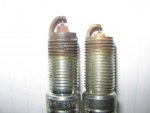A short description, projected spark plug.
"When selecting the spark plug “nose” configuration, the simple rule to remember is: The more the spark plug is exposed to the air/fuel mixture, the easier it is to initiate combustion. Many specialized plugs have been developed for high-end race cars, but for most dual-purpose vehicles the choice typically boils down to either regular-gap (conventional) or projected-nose styles.
The regular-gap plug is the traditional configuration factory-installed on many classic musclecars. For modern high-performance work, it should only be used if there isn’t enough clearance for a projected-nose plug. The latter style “projects” the spark further into the chamber than a standard plug, and will nearly always offer improved performance if there is sufficient valve and piston clearance, although many nitrous oxide users prefer to stay away from them because of excessive heat buildup in the tip that can cause detonation.
Projected plugs initiate the flame-front closer to the center of the combustion chamber, which has an effect similar to advancing the timing. This lets the total ignition advance be reduced, decreasing the chances of detonation while providing superior throttle response. A projected plug’s longer core nose provides a hotter plug at low speed to help prevent fouling. As engine speed increases, the incoming air/fuel mixture flows across the core nose tip, providing charge cooling that effectively reduces the heat range for increased top-end detonation resistance. Today many race cars also used projected-nose plugs, albeit in highly modified form from the “civilian” versions—the ground electrodes are often cut back to help improve the flame kernel and reduce the voltage amount needed to fire the plug".
http://www.hotrod.com/how-to/engine/spark-plugs-tips/




